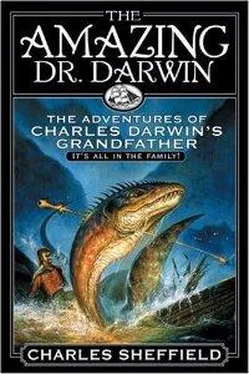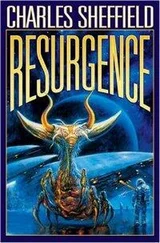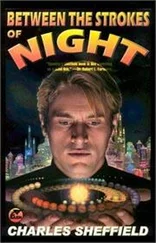The Lunar Society met once a month, on the night of the full moon so that members could ride home by moonlight. Its attendees, most of them regulars, sound like a catalog of the most influential figures of the time:
—James Watt, the key figure in the development of steam power;
—Josiah Wedgewood, whose pottery in the second half of the eighteenth century became world-famous, a reputation it enjoys to this day;
—Matthew Boulton, England’s leading industrialist of the time, whose metal works at Soho near Birmingham were also world-famous;
—Joseph Priestley, one of the founders of modern chemistry, whose move away from Birmingham upset him more for the loss of his colleagues at the Lunar Society than for any other reason;
—Samuel Galton, another wealthy industrialist whose grandson was Francis Galton, the pioneer of genetics and statistics;
—John Baskerville, the printer and typographer who created the wonderful Baskerville Bibles;
—Thomas Day, the author of the famous (but unspeakably sermonizing) The History of Sandford and Merton , a book which was still being inflicted on English youth as school prizes a hundred years later;
—William Murdock, the inventor of coal gas generation, gas lighting, and steam locomotives.
And of course there was Darwin himself. This whole group of men enjoyed fame in their own time, and helped to launch the Industrial Revolution in England.
Darwin was more than a founder, organizer, and stimulant to the Lunar Society. He was mechanically ingenious and a prolific inventor, scribbling out his endless stream of ideas as his carriage bore him on the extended medical rounds of Derbyshire. He had an original approach to everything, from the mechanics of human speech to windmills to water closets to a hydrogen/oxygen rocket motor. He wrote extensively on medicine, biology, physics, technology, gardening, agriculture, and the education of the young.
On the personal side, Darwin’s appearance—even as told by his friends—does not sound too attractive. He became very fat by early middle age, to the point where by 1776 a semicircular section had been removed from his dinner table to make room for his belly. His face was badly marked by early smallpox, and he lost his front teeth while still a young man. The defense of his appearance by his good friend Anna Seward tells us more perhaps than it intended. Even though Darwin had lost his teeth, she says, and he did look like a butcher, it was untrue to claim, as others had done, that his tongue hung out like a dog’s when he walked.
Looks aside, Darwin generally enjoyed good health and had an excellent appetite (“Eat or be eaten” was one of his mottoes). He suffered somewhat from gout, which he treated himself by abstinence from alcohol. He broke his kneecap in 1768, when he was thrown out of a carriage of his own design, and was after that always slightly lame. That he was able at the age of fifty to woo and win a rich and attractive widow, against the competition of handsome young rivals, suggests that Darwin’s appearance was no hindrance to his enjoyment of life.
There are six biographies of Darwin that I suggest as good reading: Anna Seward’s contemporary account, published in 1804; Charles Darwin’s account of his grandfather’s life, drawn mainly from family documents and published in 1887; Hesketh Pearson’s 1930 biography; Maureen McNeil’s 1987 book, Under the Banner of Science , which sets Darwin in the context of the politics and science of his time; and two highly readable biographies by Desmond King-Hele, Erasmus Darwin (1964) and Doctor of Revolution (1977), which offer the most rounded picture of the whole man. In drawing from these and other sources, I have tried to provide a fictional picture of Darwin that is consistent with the real man, in both his habits and his attitudes. For example, Darwin was not religious, and also not afraid to say so—something not common in his time. But his attitude to his fellow humans was always one of unusual benevolence and sympathy, regardless of differences in viewpoint.
Having followed the facts with Darwin in these stories, I must now say that the other characters presented here are largely fabrication. Darwin did know a Colonel Pole (Sacheverel, not Jacob), and following the Colonel’s death married his widow; but there is no evidence that the two men were good friends—and some evidence to the contrary. Since the actions of these stories takes place in the second half of the 1770s I also found it convenient to transport Pole’s house at Derby over to Lichfield, so as to make him a closer neighbor to Darwin. There is no evidence at all that the good colonel was an inveterate treasure hunter.
If most of the people other than Darwin and the members of the Lunar Society are inventions, the backgrounds to the stories are not.
* * *
The Devil of Malkirk
After the Rebellion of 1745-46 in Scotland, and the defeat at Culloden of Bonnie Prince Charlie (Prince Charles Edward, the Young Pretender), the Scots were forbidden by the Disarming Act to carry weapons. A first offense carried a fine of fifteen pounds sterling, a second offense meant transportation. The Scots were also forbidden to wear the kilt and other Highland dress until that ban was lifted in 1782.
Prince Charles Edward supposedly died in Rome in January 1788, still in exile. However, there had been in the 1750s and 1760s many rumors of his visits to England and to Scotland, in disguise and perhaps with a double to front for him in Europe. If the Prince had suffered a fatal accident while in Scotland, would the double have continued the royal imposture? I am willing to admit that possibility, and I assumed it in “The Devil of Malkirk.”
The Heart of Ahura Mazda
Given the universally inquisitive and worldly nature of both men, it is hardly surprising that Erasmus Darwin and Benjamin Franklin would also be good friends. Darwin was twenty-five years younger, and admired the older man enormously both as scientist and politician. They met sometime before 1760, probably in 1758, and kept in touch up to Franklin’s death in 1790. Naturally, Darwin followed closely Franklin’s researches into electricity, which stands him in good stead in unraveling the mystery of “The Heart of Ahura Mazda.”
The “lost rivers” of London, which the men follow in this story, are accurate both as to names and locations. The character of Joseph Faulkner resembles Franklin in age, nationality, and appearance, all the way to the bald head and fur hat. However, it seemed better to restrict the allusion to physical resemblance; just like Erasmus Darwin and Samuel Johnson in a single city, Darwin and Franklin would offer each other too much competition to be the lead character in a single story.
The Phantom of Dunwell Cove
“The Phantom of Dunwell Cove” invented little. Joseph Priestley was working with dephlogisticated air—his name for oxygen—in the 1770s, and Darwin would indeed have been keen to attend the Lunar Society meeting and hear of the latest progress. The influence of the Gulf Stream in tempering the climate of Devon and Cornwall was well known, and many an Englishman looked forward to an early spring journey to England’s southwestern peninsula. The only explicit change to history is in timing. Humphry Davy learned of the anesthetic properties of nitrous oxide only in 1799. He reported becoming “absolutely intoxicated” after breathing sixteen quarts of it. Richard Dunwell is presumed to have discovered and used the gas twenty-some years earlier. That is unlikely, but certainly not impossible in an age of reduced communication.
Читать дальше












